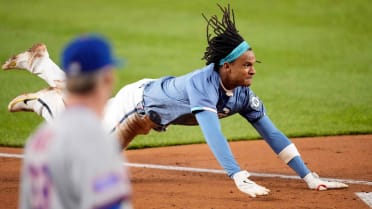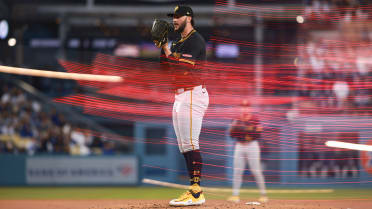On Friday, Major League Baseball announced that this year’s Draft will be held on June 10-11. Here’s everything you need to know:
Broadcast and logistics details
The five-round Draft will begin on Wednesday, June 10 at 7 p.m. ET, with both MLB Network and ESPN producing live coverage -- the first time more than one network will provide live primetime coverage of the event. The first night of coverage will span the first 37 picks, covering the first round and Competitive Balance Round A.
Coverage continues on Thursday, June 11 on MLB Network and ESPN2 at 5 p.m. ET and will pick up with the start of the second round (pick No. 38) and run through the end of the fifth and final round of this year’s Draft. There will be a total of 160 picks in the 2020 Draft.The Draft usually runs 40 rounds but was shortened this year in response to the coronavirus pandemic.
Draft order
The Detroit Tigers have the No. 1 pick in this year’s Draft by virtue of having the worst record in baseball in 2019. The top 10 is as follows:
- Tigers
- Orioles
- Marlins
- Royals
- Blue Jays
- Mariners
- Pirates
- Padres
- Rockies
- Angels
The Giants and the Cardinals have the most selections of any team in this year’s Draft, with seven. San Francisco’s extra picks come courtesy of compensation for losing Madison Bumgarner and Will Smith to free agency, while the Cardinals have a Competitive Balance Round B pick and a compensation pick for free agent Marcell Ozuna. A total of 14 teams have six selections in the five-round event.
On the other side of the ledger, the Yankees have the fewest picks, with three, having given up their second- and fifth-round selections for signing free agent Gerrit Cole. Six teams have four selections, including the Astros, who forfeited their first- and second-round selections as part of the penalties for illegally stealing signs (They added a pick as compensation for losing Cole.). The Red Sox also are among the clubs with four picks, having forfeited their second-round pick as part of their sign-stealing penalties.
Bonus pools & slot values
Under the Collective Bargaining Agreement, each team gets an allotted bonus pool equal to the sum of the values of that club’s selections in the first 10 rounds of the Draft. The more picks a team has, and the earlier it picks, the larger the pool. This year, with a five-round Draft, all signing bonuses will apply toward the bonus pool total.
Normally, any bonus greater than $125,000 for a player taken after the 10th round is also applied toward the total. This year, there is a $20,000 limit on bonuses for non-drafted free agents. There is no limit to the number of undrafted players teams may sign, but they cannot go over $20,000 per player. These bonuses do not count toward the bonus pool.
Had this been a normal year, the slot value assigned to each pick in the top 10 rounds would have gone up 3.5 percent compared to 2019, the same amount MLB’s annual revenues increased. But as part of the reaction to the pandemic, an agreement was struck that slot values would remain the same as 2019, both for this year’s Draft and the 2021 edition.
The Tigers' top pick comes with an assigned value of $8,415,300, compared to $7,789,900 for the Orioles' No. 2 overall pick. Because Baltimore’s Competitive Balance Round pick is much higher than Detroit’s (No. 30 versus No. 62), its overall bonus pool is slightly higher ($13,894,300 vs. $13,325,700)
The Royals ($12,521,300), Marlins ($12,016,900), Pirates ($11,154,500), Padres ($10,674,000), Rockies ($10,339,700) and Mariners ($10,265,500) also have eight-figure bonus pools. The Astros, having lost their first- and second-round choices, have the smallest pool at $2,202,600.
Top prospects
The top of MLB Pipeline’s Draft Top 200 list is very college-heavy, with the top six all hailing from big four-year programs. It starts with Arizona State first baseman Spencer Torkelson, the player most project as the frontrunner to be the Tigers’ selection at No. 1. Vanderbilt’s Austin Martin is at No. 2, and the two college bats are followed by arms: Texas A&M lefty Asa Lacy and Georgia right-hander Emerson Hancock. There’s only one high school player in the top 10:
- Spencer Torkelson, 1B, Arizona St.
- Austin Martin, OF/3B, Vanderbilt
- Asa Lacy, LHP, Texas A&M
- Emerson Hancock, RHP, Georgia
- Nick Gonzales, SS/2B, New Mexico St.
- Garett Mitchell, OF, UCLA
- Zac Veen, OF, Spruce Creek HS (Fla.)
- Reid Detmers, LHP, Louisville
- Max Meyer, RHP, Minnesota
- Heston Kjerstad, OF, Arkansas**
Complete list »**
Impact of five-round Draft
The first, and most obvious, ramification of the Draft being reduced to five rounds is that teams are simply going to be signing a lot fewer players than in most years. But with no Minor League baseball being played, there is nowhere for those players to go out and play. The flip side of that coin could be that the 2021 Draft might be incredibly deep. Typically, the best college players sign after their junior year, but many could choose to head back to college if they aren’t drafted and re-enter the Draft next year, rather than signing for the $20,000 maximum.
In addition to more college players staying for their senior years, we could also see more high school players head to college for the same reasons. Players who go to junior college can re-enter the Draft next year, and players who head to four-year schools will be draft-eligible again in 2023.
And because of a lack of a full spring season, teams will, more than ever, be relying on evaluations from the past summer, when scouts got good looks at top players in college leagues and the high school showcase circuit. It provided less chance for a player to “pop up” with a strong spring performance.
But even with all the uncertainty, it’s still about lining up players and taking the best player on the board at the time.
“We have prepared with the same principles that we always have,” a National League scouting director said. “We’ve had more meetings, we’re using more data. There’s more influence put on the past for obvious reasons.
“Zoom and Microsoft Team are our new normal. We will line up the board the same way, though. The $20,000 rule after the fifth will be interesting. We have no idea how that will play out.”
Teams will now have until August 1, pushed back from July 10, to sign drafted players.
Jonathan Mayo is a reporter for MLBPipeline.com. Follow him on Facebook and @JonathanMayo, and listen to him on the weekly MLB Pipeline Podcast.




